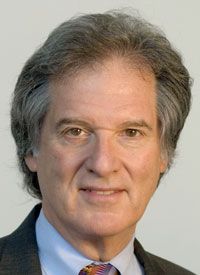Rituximab Plus Lenalidomide Shows Promise in First-Line Setting for Follicular Lymphoma
Based on data reported at the 2018 ASCO Annual Meeting, the primary endpoint of the phase III RELEVANCE trial was not met with the combination of rituximab plus lenalidomide showing similar efficacy results compared with rituximab plus chemotherapy in treatment-naive patients with follicular lymphoma. The chemotherapy-free regimen, however, did show a more favorable toxicity profile.
Nathan Fowler, MD

Nathan Fowler, MD
Based on data reported at the 2018 ASCO Annual Meeting, the primary endpoint of the phase III RELEVANCE trial was not met with the combination of rituximab (Rituxan) plus lenalidomide (Revlimid) showing similar efficacy results compared with rituximab plus chemotherapy in treatment-naive patients with follicular lymphoma.
The chemotherapy-free regimen, however, did show a more favorable toxicity profile, which could lead to the treatment regimen being a new potential option for patients with follicular lymphoma, Nathan H. Fowler, MD, suggested.
"Rituximab/lenalidomide was not superior to rituximab/chemotherapy, based on mature CR/CRu analysis. It is very important to know, as we might expect, there are differences in safety profiles between arms," said Fowler, the lead investigator and an associate professor at The University of Texas MD Anderson Cancer Center. "These results show that lenalidomide/rituximab, which is a novel immunomodulatory approach, is a potential first-line option for patients with FL who require treatment."
After 120 weeks, the rituximab/lenalidomide combination, known as R2, showed a complete remission (CR) or unconfirmed CR rate of 48% compared with 53% for rituximab/chemotherapy (P= .13). The objective response rate (ORR) with the R2regimen was 84% compared with 89% for rituximab/chemotherapy. The 3-year duration of response was 77% with R2compared with 74% for rituximab/chemotherapy.
The study, which started in 2012, was designed prior to a full understanding of the benefits of the R2combination, Fowler noted. "In retrospect, this would have been better as a non-inferiority trial, but it was designed with the data that we had,” he said. "We didn't have clear progression-free survival data from any of the phase II trials when this study was designed. All we had was overall response and CR rates."
The RELEVANCE trial randomized 1030 patients to receive R2(n = 513) or rituximab/chemotherapy (n = 517), which consisted of R-CHOP (72%), rituximab/bendamustine (23%), and R-CVP (5%). The chemotherapy regimens were given at standard doses. In the R2arm, lenalidomide was administered at 20 mg/day on days 2 through 22 of a 28-day cycle until CR/CRu then at 10 mg/day. Rituximab was given at 375 mg/m2weekly in cycle 1 and then on day 1 of cycle 2 through 6. It was continued in responders every 8 weeks for 12 cycles.
Baseline characteristics were well-balanced across groups. The median age in both arms was 59 years and two-thirds of patients were ECOG performance status 0. Bulky disease (>7 cm) was found in 42% of those in the R2group and for 38% in the rituximab/chemotherapy group. FLIPI score was low (15%), intermediate (36% to 37%), and high (48% to 49%). B symptoms were presented for approximately one-quarter of patients.
At a median follow-up of 37.9 months, progression-free survival (PFS) was similar in both arms, Fowler said. By independent review, 3-year PFS rate was 77% with R2compared with 78% for rituximab/chemotherapy (HR, 1.10; 95% CI, 0.85-1.43;P= .048). By investigator assessment, the 3-year PFS rate was 77% with R2and 78% with rituximab/chemotherapy (HR, 0.94; 95% CI, 0.73-1.22;P= 0.63).
Overall survival (OS) remained immature at the time of the analysis, which had a data cutoff of May 2017. The 3-year OS rate was 94% (95% CI, 91%-96%) with R2compared with 94% (95% CI, 91%-96%) for rituximab/chemotherapy (HR, 1.16; 95% CI, 0.72-1.86).
The rate of grade 3/4 neutropenia was 32% for patients treated with R2 compared with 50% for rituximab/chemotherapy. The grade 4 rates were 8% and 31%, respectively. Just 1% of patients in the R2 arm had an absolute neutrophil count nadir of <100/μL compared with 6% for rituximab/chemotherapy. Moreover, the time to grade 3/4 neutropenia was significantly longer with the chemotherapy-free regimen (3.7 vs 0.6 months).
All patients in each group experienced treatment-emergent adverse events (TEAEs). The rage of grade ≥3 TEAEs was higher in the chemotherapy arm (approximately 60% vs 70%). Grade 3/4 infections were twice as likely in the chemotherapy arm (2% vs 4%) and more patients experienced febrile neutropenia in the chemotherapy group (2% vs 7%). Febrile neutropenia requiring hospitalization was more than double in the chemotherapy arm (2% vs 5%) and nearly 3-times as many patients received growth factor agents in the chemotherapy group compared with R2(23% vs 68%).
Although most TEAEs were more common the in the chemotherapy arm, there was a higher rate of rash in the R2group. Grade ≥3 rash was experienced by 7% of those in the R2group compared with 1% for the rituximab/chemotherapy arm.
"Rituximab/chemotherapy resulted in more frequent neutropenia, febrile neutropenia, growth factor usage, nausea, vomiting, neuropathy, and alopecia," said Fowler. "R2caused more frequent cutaneous reactions, tumor flare, and diarrhea."
The development of secondary primary malignancies (SPM) was similar in each arm. In the R2group, 7% of patients developed an SPM compared with 10% in the rituximab/chemotherapy arm. Invasive SPMs occurred in 5% of patients in each group.
Bruce D. Cheson, MD

Bruce D. Cheson, MD
"With this study, we had a prime opportunity to examine second primary cancers. There was no significant difference between each arm," said Fowler. "There was no difference in cause of death between both arms."
Findings from the study were discussed by Bruce D. Cheson, MD, following the presentation of the results at the ASCO meeting. He agreed with Fowler’s assessment of the trial, and suggested that R2should become an available frontline option.
"Unfortunately, this was designed as a superiority trial and not a noninferiority trial. Therefore, it failed to meet its primary endpoint of superior CR/CRu at 120 weeks," said Cheson, deputy chief, Division of Hematology/Oncology in the Department of Medicine at Lombardi Comprehensive Cancer Center.
"However, R2showed a similar PFS at 120 weeks in all major patient subgroups, similar overall survival, less non-hematologic toxicityexcept for rash—and less neutropenia, febrile neutropenia, and fewer infections, despite the increased use of growth factors with chemoimmunotherapy," he said. "Therefore, I agree with Dr Fowler's conclusion. R2can be used as a frontline therapy in patients with follicular lymphoma.”
Reference:
Fowler NH, Morschhauser F, Feugier P, et al. RELEVANCE: Phase III randomized study of lenalidomide plus rituximab (R2) versus chemotherapy plus rituximab, followed by rituximab maintenance, in patients with previously untreated follicular lymphoma.J Clin Oncol. 2018;36 (suppl; abstr 7500).
Outcomes were similar across prespecified subgroups for PFS. There were some outliers, although the overall patient numbers were small and these findings were not statistically significant. For those with stage I/II disease, the HR was 2.23 (95% CI, 0.66-7.55) and for those with FLIPI score 0 to 1, the HR was 2.06 (95% CI, 0.88-4.80).
Examining the Non-Hodgkin Lymphoma Treatment Paradigm
July 15th 2022In season 3, episode 6 of Targeted Talks, Yazan Samhouri, MD, discusses the exciting new agents for the treatment of non-Hodgkin lymphoma, the clinical trials that support their use, and hopes for the future of treatment.
Listen